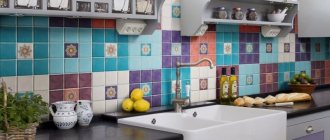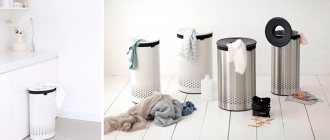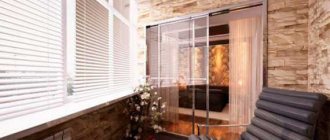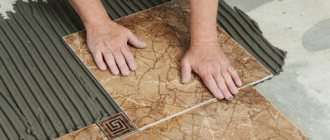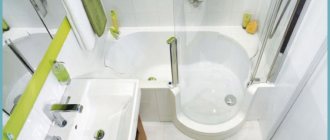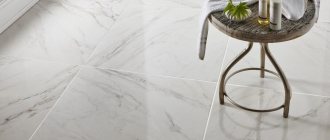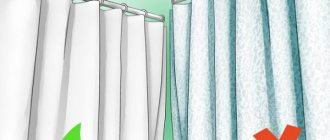Causes of plaque formation
The surface of the tiles in the bathroom is constantly exposed to water, soap solutions, and cosmetics. The liquid part evaporates, the drops dry out, leaving stains of salts, lime and other substances dissolved in water on the shiny tile.
It is not difficult to clean the tiles from dirt: water-soluble salts are wiped off with a sponge or rag. But in some cases, stains cannot be removed. The reasons for this may be:
- increased water hardness: after the moisture evaporates, insoluble lime compounds remain, which form white stains on the tiles;
- leaking taps: they stain the wall with rust, and after the drops dry, the yellowness is difficult to wash off;
- mold fungi: colonize tile joints, constantly appearing on the surface in the form of dark spots resembling dirt, and an unpleasant odor appears in the bathroom;
- consequences of the repair: drops of lime, paint, putty or grouting materials are easily washed off until completely set (within 24 hours), and after that they are more difficult to remove.
Washing tiles in the bathroom.
Folk remedies
Every housewife has in her arsenal many available means to combat pollution of any complexity.
- If you have an old dried lemon , do not rush to throw it away, but rather squeeze the juice out of it, dilute it with cold water and wipe the walls and floor in the bathroom. In addition to sparkling cleanliness, you will receive complete disinfection and a pleasant citrus aroma. If there is no lemon, then you can use citric acid by diluting it in warm water.
- Dilute 20 g of vinegar essence in half a liter of cool water and place in a spray bottle. Wet the tiled walls of the room generously, and after a few minutes wipe with a dry cloth. If you use this product every day, mold will never form in your bathroom.
- Ammonia is successfully used to clean window glass and mirror surfaces. It can also be used to clean tiles. Mix 2 liters of cold water with two tablespoons of ammonia. Take a soft cloth, moisten it generously and apply the solution to the wall, leave for a quarter of an hour and rinse with clean water. Then rub the walls with a dry flannel cloth.
- Treat particularly problematic areas with baking soda.. Wet the sponge generously, apply baking soda to it and treat the stains. Be careful not to let the cloth dry, as dry baking soda can scratch the tile.
Dampened baking soda turns into a paste and easily cleans the dirtiest walls. - Use laundry soap to clean tiles. Grate half a piece on a fine grater and dissolve 3 tablespoons in 0.5 liters of hot water. Stir the solution until the soap is completely dissolved and apply the solution to the wall. After a short time, wash the walls with hot water, rinse with cold water and wipe dry.
We should not disdain the recipes for cleanliness known to our grandmothers. - If you just can’t get rid of soap stains on the tiles, then use regular tooth powder . Mix a few spoons of powder with the same amount of water to make a homogeneous paste. Apply this mixture to the wall and let it dry. Then carefully remove from the walls with a rubber or acrylic scraper. Then wipe the walls with a damp cloth.
General cleaning recommendations
You need to choose a cleaning agent to remove stains from tiles depending on the type of coating (tile, plastic, terracotta, etc.), as well as taking into account the type of dirt. Fresh stains of any origin can be easily wiped off with a soap and soda solution. Soda, as a soft abrasive, can even cope with rust or lime salts. But old stains will have to be removed with aggressive household chemicals.
Washing tiles with soap and soda solution.
To prevent damage to the wall covering during cleaning, you must follow the following rules for caring for it:
- when using acid-containing chemicals, protect tile joints;
- do not use hard metal sponges and brushes, do not scratch stains with a knife;
- It is better to choose thick gels;
- It will be possible to wash the tiles without streaks only by thoroughly rinsing the surface;
- After treatment, mirror glass tiles must be wiped with window cleaners until they shine.
Home Remedies
Improvised products are used in emergency situations, when you need to wash away dirt, but it is not possible to buy a suitable product. Limescale removal is carried out using acidic solutions:
Vinegar and lemon juice remove limescale from tiles.
- Vinegar dissolves traces of water droplets and will help remove grout or lime stains. Table varieties should be diluted with water 1:1, and for essence use 1 tsp. for ¾ glass of water. Soak a cloth in the solution and wash the tiles, rinse and wipe.
- Lemon juice or acid solution works in the same way as vinegar. You can use pure lemon juice or an acid solution of 1 tsp. for 1 glass of water.
You can remove cloudy deposits from drops of soapy water on the lining near the sink and bathtub using baking soda: moisten the powder, apply it to a sponge and wipe the wet wall. Rinse off the remaining soda with plenty of water so that there are no streaks from the powder itself.
An old toothbrush is useful for cleaning tile seams, joints in corners and other hard-to-reach places. It is convenient to treat smooth walls with a sponge. For wiping dry, rags made from natural fabrics are suitable.
Household chemicals
- Table vinegar. It is in every home, we usually use it in the kitchen. But it can also be used well in the bathroom to clean grout and tiles - both from plaque and pathogenic microbes. To clean grout lines, you can use undiluted vinegar, but for the surface of the entire tile, it is better to dilute it in a ratio of 1 to 10; if necessary, the concentration can be increased. It is convenient to clean the seams with an old toothbrush, and apply vinegar to the rest of the surface for 10–15 minutes, then wipe with a rag and rinse with water.
- Lemon acid. A product similar in quality to vinegar, only weaker. But it has such an important advantage as a pleasant citrus smell after finishing cleaning.
- Bleaching, "Whiteness". It has been known since ancient times for its disinfecting properties and can wash away dirt and plaque, even remove mold stains. It is worth knowing that seams are bleached if they are colored or the shade of white becomes lighter. Therefore, before use, try cleaning a piece of seam with undiluted white to check. To clean the lining in the bathroom, you need to apply bleach and leave for 10 minutes, then rinse.
- Ammonia. It is used only in diluted form, as it has too strong a smell. Dilute 1-2 tablespoons in 2-3 liters of water. Helps not only clean the tiles, but also restore the gloss to its former shine! To do this, it is better to use a more concentrated solution of ammonia.
You can use the most common home remedies for cleaning.
- Soda. It’s also a proven cleaning product, sometimes it does a better job than many specialized products. It can be used to clean both plaque and mildly rooted fungus. To use, it is best to dilute it with water until it becomes sour cream. To give soda antiseptic properties, you can use it with the addition of hydrogen peroxide - then the microbes, along with fungus and mold, will be destroyed. You just have to know that you shouldn’t rub soda with special zeal, especially into glossy tiles, since soda contains small abrasives. After using soda, you must thoroughly wash and dry the treated surface.
- Borax. Used to remove fungus and mold. Does not cause allergies. Dilute with water 1 to 10 and clean with a brush. No need to wash after use.
- Copper sulfate. The fungus can be cleaned with vitriol, but it is toxic and should be used in well-ventilated areas. Dilute 1 to 10 and apply to the affected areas with a brush for several hours. After which it is thoroughly washed and dried.
Cleaning tiles using traditional methods
If the use of reliable but caustic chemicals is not possible, you can remove dirt and stains on the walls of the bathroom and bring the tiles to a shine using the folk method. You will need:
- 100 ml hot water;
- 100 g of sound soap shavings;
- 2 tbsp. l. hydrogen peroxide;
- 2 tbsp. l. table vinegar (6-9%);
- 75 g baking soda.
Using a special solution prepared at home, you can give the tiles their former shine and shine.
Dissolve the soap in water, adding it in small portions. Add baking soda powder and leave the mixture for 24 hours. Add the remaining ingredients, moisten the tile with water and apply the prepared mixture. Leave for 5-7 minutes, then rub the seams with a brush, rinse the surface of the wall or floor with a sponge. Finally, rinse thoroughly with water and wipe dry.
An ammonia aqueous solution, which is used to wash glass, will also work well with stains on tiles or other glossy tiles (porcelain, mirror, etc.). Ammonia is used after washing the walls in the bathroom to bring the tiles to a shine. Glass cleaners can be used for the same purpose.
Preventive measures
Some rules that will make bathroom cleaning and renovation easier, thanks to which you won’t have to use aggressive methods.
- During repairs, it is advisable to immediately remove traces of primer and glue, while the mixtures have not yet dried.
- When taking a bath or shower, remove traces of moisture and drops from the walls.
- Provide ventilation of the room.
- Use a high-quality towel dryer that does not blow hot air.
- Monitor the condition of pipes, faucets, showers. Avoid leaks.
- Periodically check the condition of sewer pipes.
- Carry out preventative cleaning before complex stains form.
- To create ventilation, you can purchase special doors with a ventilation system or a wall fan.
- Do not store wooden items in the bathroom.
- If there is no towel dryer, it is advisable to remove wet towels from the bathroom.
- Periodically make cosmetic repairs and check the condition of the walls and floors under the ceramic tiles.
- Use only moisture-resistant or waterproof materials to cover bathroom floors and walls.
- Wash the carpet and change the shower curtains on time.
Specialized household chemicals
Many products only remove fresh dirt well. It is difficult to remove old limescale or rust with them.
Silit Bang dissolves fats and breaks down lime deposits.
At home, it is convenient to use strong but not too aggressive drugs:
- "Silit Bang". Breaks down fats, dissolves lime deposits, and can remove yellow rust stains. The composition is non-aggressive towards all materials used for cladding: it can be used to clean acrylic and various types of plastic, porcelain stoneware, tiles with various surfaces, glass.
- "Mister Muscle". Dissolves soap and lime stains, is easily washed off with water and leaves no marks on different types of wall coverings.
- "Comet". The products are available in the form of sprays and gels with cleaning properties. If you need to quickly wipe clean surfaces to maintain shine, use a spray, but it is more convenient to treat difficult stains with gels.
- Kiilto Clean for tiles. The product contains oxalic acid and is harmless to glossy glazed ceramic surfaces, but can damage gypsum grout.
- "Domestos". Thick gels and sprays have a bactericidal effect. The bathroom will not only be clean, but also safe for health. When mold appears, the tile joints are treated with thick gel.
Domestes rids tiles of mold.
Features of washing different types of tiles
When trying to wipe dirt off tiles, it is advisable to take into account the nature of the surface. On smooth, glossy walls, plaque forms quickly, but it is easy to visually detect and remove immediately. Other types of ceramic tiles need to be cleaned properly to achieve a satisfactory result.
Glossy
Glossy surfaces are especially difficult to keep clean. But it is also easier to remove stains from them than from other types of tiles. Plaque is removed from the glaze using chemicals that contain ammonia or ethyl alcohol: these are most products for window glass. The preparations are equipped with a spray bottle, are easy to apply, and when wiped dry, the surface becomes shiny.
Window glass cleaners are most often used to clean glossy surfaces in the bathroom.
Matte tile
Ceramic tiles without glaze are covered with stains from soap solutions or water. You can eliminate them:
- acidified water (0.5 cup per 5 liters of water), if they are caused by lime deposits;
- a solution of soda ash (3 tablespoons per 5 liters of water);
- special polish.
Cleaning matte tiles in the bathroom.
Embossed
The textured surface of the tile makes it difficult to remove dirt with a simple rag or sponge: not only plaque or rust remains in the small recesses of the pattern, but also dirty water after washing. If they are not removed immediately, they will create a dark coating. For cleaning, it is better to use special products that are completely washed off. The most convenient way to clean an uneven surface with an ornament or simply a fine texture is with a brush. After washing, it is advisable to wipe the wall or floor with moisture-absorbing material.
It is better to wash embossed tiles with special products.
Floor
For bathroom flooring, tiles with fine relief or without glaze are often used. These types are the safest: they will not allow you to slip on a wet floor. They need to be cleaned taking into account the characteristics of the surface, according to the rules for matte or embossed tiles. For floor tiles, special polishes are used (Emsal, etc.), which do not allow dirt to seep into the micropores of the ceramic.
For flooring, you should choose special polishes.
Cleaning products
Stores offering products from the household chemicals group always have special products for cleaning tiles. The compositions are developed taking into account the quality of the material and the characteristics of contamination, allowing you to remove plaque of any origin. Most compositions contain isopropyl alcohol, ammonia, and mild solvents.
The following brands are popular:
- "Sif";
- "Domestos";
- "Mister Muscle";
- SunClean;
- Cillit Bang;
- "Comet".
“Shining Tile”, “Shumanit”, and other solutions, gels, and pastes that have certificates have good cleaning properties. When choosing, you should read the instructions, make sure the purpose of the tile cleaner, and pay attention to the rules of use. If there are no special formulations in the nearest store, you can use high-quality dishwashing solutions. According to housewives, they also allow you to remove plaque and soap stains and bring the bathroom back to normal condition.
You can successfully clean the tiles in the bathroom from plaque using home remedies that you can always find in your apartment and are inexpensive.
Interesting! An ordinary soap solution is suitable, which must be applied with a sponge to the entire surface, wait a little and rinse thoroughly with clean water using rubbing movements.
Washing with water after using a soap solution is a mandatory, important step, neglect of which will result in stains remaining on the tiles.
It is useful to moisten limescale stains with vinegar using spray bottles or dampened cloth swabs. It is enough to pour a quarter cup of food vinegar solution into a liter jar of water; the resulting concentration will allow the hardness salts to dissolve. A simple life hack allows you to deal with many types of dirt cheaply and effectively.
Citric acid removes plaque even more successfully. True, it costs more than vinegar. The powder can be applied to a wet cloth and used to treat the dirt, making sure that the crystals dissolve and turn into a paste. After half an hour, the dirt on the tiles will disappear.
Some housewives like to use slightly moistened soda powder. Although it can easily clean tiles from ordinary dirt, it is not so successful in removing lime salts.
Interesting! Baking soda creates an alkaline environment that salt deposits from hard water do not react to.
Effective preparations allow you to quickly clean tiles with minimal effort. To consolidate the result at the end of the procedure, you need to wash the walls with clean water and wipe with a napkin, then the surface will shine like new.
Prohibited means
It is not easy to clean the tiles in the bathroom from limescale deposits that have accumulated and become firmly ingrained into the tiles. Sometimes there is a desire to rub at least a little area of dirt with abrasive powder.
Important! You should absolutely not use products with solid particles.
The salt deposit can be cleaned off quickly, but as a result, small cracks will appear on the tiles, which over time will aggravate the situation and provoke the accumulation of salts and dirt. You need to be patient and methodically clean limescale stains with products without abrasive particles. If you clean them regularly, there will be no problems in the future.
How to clean the seams between tiles
Cleaning the joints between tiles.
The grout has many pores into which dirty cleaning solution, drops of soapy water and other substances become clogged. Fungus and mold often develop in the pores.
To treat the seams, use a small brush and any cleaning product with bactericidal properties. The composition of a folk or store remedy should not include acid. A soap-soda solution is suitable (for 1 liter of water, 50 g of soap shavings and 2 tablespoons of soda). Add 1 cap of “Whiteness” or 0.5 tsp to it. chloramine.
It is convenient to use a steam generator to clean seams. A jet of hot steam destroys dirt and microorganism spores.
Mold Removal
Mold appears as small black spots in the joints of tiles. The peculiarity of the fungus is its ability to live and grow deeply into the plaster, from where it is completely impossible to remove it without repairs. A steam cleaner will quickly fix the problem. If mold was already in the bathroom before the new tiles were installed, the effect will be temporary.
Chlorine bleach will help fight mold on tiles.
Chlorine bleaches are effective against fungus on surfaces, but cannot completely destroy it. To permanently fix the problem, you need to use a radical method - remove the old putty and fill the joints with new grout. A special tool is used to remove the gypsum mixture, and the remains are removed with a brush.
Anti-mold treatment is as follows:
- Inject a fungicidal antiseptic into the seams, trying to wet the entire space between the seams (use a syringe);
- dry the wall;
- fill the joints with new putty, pushing it into the depth of the seam;
- wipe the surface of the tiles.
After introducing the fungicidal antiseptic and drying the wall, it is necessary to reapply the putty.
Methods for restoring grout
There are several effective ways to update and lighten seams:
Marker for cleaning tile joints.
- Hardware stores sell products for cleaning bathroom tile joints. Markers and pencils allow you to quickly work on a seam by running the end of the lead along it.
- Paint the seams with waterproof paint or varnish and cover with polish.
- Partially renew the grout. This process is often combined with mold removal.
- If the putty has crumbled, it can be renewed by applying a fresh layer of the same composition. Before repairs, treat the joints with a stiff brush to remove the crumbling layer.
How to clean bathroom tiles after renovation
Often after repairs, traces of cement, tile adhesive and other construction compounds and mixtures remain on surfaces. Cleaning bathroom tiles after the mixtures have dried is a very difficult task. There is a remover for cement in stores. For example, Atlas, Olympus, Docker Zement, Docker Epoxy (G), Keranet Mapeib and others. They are applied, waited for some time, then the crumbling cement mortar is removed with a stiff brush.
Dried cement and adhesive mixtures based on it are removed using acid solutions. Any acid will do - from diluted hydrochloric acid to citric acid and ordinary vinegar. You must work with acids carefully: wear gloves and a respirator with good ventilation. As the acid corrodes the cement, it can be removed, and after cleaning, rinse with water.
Due to the presence of special additives, tile adhesive cannot always be removed like ordinary cement mortar. You can find special cleaning products in hardware stores. For example, Tiprom-OTs, Keranet, AtlasSzop and others. They are applied to the surface, left for some time (indicated in the instructions), then the softened composition is removed with little effort. This method of cleaning bathroom tiles from tile adhesive is suitable for dirty surfaces.
Sometimes a situation arises when the tile falls off along with the glue. Once cleaned, it must be put back in place. It is too wasteful to soften the glue with chemicals - they are not cheap. All that remains is mechanical removal. If the layer is large - more than 0.5 cm, it is cut into squares with a diamond disc. After placing the treated tile on its edge, use a chisel to chop off pieces of glue. Anything that has not broken off can be left or removed using a sanding disc. This kind of work will generate a lot of dust, so it’s better to do it outside. You can reduce the amount of dust and make the task a little easier by soaking the tiles in water. The glue will absorb some of it, although it is positioned as moisture resistant.
If the glue layer is thin, you can try to chip it off in layers; if it doesn’t work, you can sand it. It is unrealistic to process a large number of tiles in this way, but a few can be prepared.
Useful tips and prevention
To ensure that the seams are less exposed to moisture or cleaning agents, it is recommended that they be treated with a moisture-proof compound immediately after the repair is completed. The grout will last longer. Polishes are also applied to tiles with a porous surface (unglazed).
The best prevention of stains on tiles is timely cleaning. It is easier to wipe the walls when the stains have not yet had time to dry to the surface. You need to wash the walls in the bathroom once a week, and clean the seams once every 2-3 weeks.
Ventilation or frequent airing of the bathroom helps eliminate excess moisture. Mold will not grow in such conditions. After washing or taking a shower, it is advisable to wipe off drops of water from the tiles: this way there will be less dampness, and you won’t have to scrub off the stains.
How to clean bathroom tiles from plaque using folk remedies
The modern construction market has been replenished with a number of new finishing materials, but tiles are still considered the best for finishing a bathtub. It is perfect for rooms with high humidity, and is also aesthetically attractive. However, if you do not take care of the tiles, then their advantages will be overshadowed by an unsightly coating, streaks and stains.
Causes of pollution
Knowing what kind of dirt appears on tiles and why, you can choose a suitable cleaning product and take timely preventive measures.
Types of tile stains
Limescale. Even after purification, the water contains salts and lime. The splashes fall on the tiles and dry, leaving whitish, rough streaks. Accumulating in one place, these drips form stable lime crystals that are difficult to remove.
Soap drips. Shampoo, gel, and soap have similar substances that, when they get on the wall, leave white stains. A glossy surface especially does not accept soap stains: it becomes matte and loses its shine.
Care products: hygiene and cosmetics. Shampoo, bath or shaving foam, toothpaste, gel leave a mark on the tiles. If these contaminants are not removed in time, plaque will form.
Mud spots. Dust and dirt after washing shoes and floors in the absence of regular cleaning of the surface can also accumulate on the tiles.
Homemade tile care products
The following will help remove limescale, soap deposits and other contaminants from tiles:
Lemon
You can remove stains and limescale by rubbing the stained area with a slice of fresh lemon. Another way is to squeeze lemon juice into a bowl of water and treat the tiles with the resulting solution. In addition to removing stains, lemon will fill the room with a pleasant aroma. Fresh fruit can be replaced with citric acid powder.
Soap solution
This option is only suitable if the tiles are regularly maintained. A soap solution will wash the tiles if they have not yet turned white. The procedure begins from the top, moving down. After washing the walls with soapy water, you need to wipe the surface dry, moving in the opposite direction.
Soda and vinegar solution
The reaction that occurs between these two substances helps deal with stubborn deposits, effectively softening them. The cleaning procedure is carried out as follows: soda powder is poured onto a damp sponge, the product is applied to the treated area, after which table vinegar is sprayed on top.
Vinegar
Use a weak concentrated solution, for example, 6%. The easiest way to treat walls is to pour vinegar into a spray bottle. Spray the product onto the walls. Wait 5–10 minutes for the substance to penetrate into the depths of the dirt, after which you can rub the tiles with a soft brush without using excessive force. If the result is not satisfactory, spray the product again. At the end of the procedure, the tiles are washed with warm water and wiped dry. Find out more effective ways to use vinegar.
Ammonia
It copes well with plaque, dirt and mold. It is diluted in water and then wiped over the surface. You can get rid of a specific smell by leaving the bathroom door open.
Dentifrice
It sounds strange, but tooth powder does a great job of removing stains on tiles. To do this, the powder is diluted in water, and the resulting mixture is poured into a bottle. Spray the product onto the walls, wait until it dries, and polish with a soft cloth.
Bleaching
A universal remedy - will remove lime deposits, restore radiant shine, kill germs and mold. Bleach powder is diluted in water and sprayed onto the walls. Leave on the surface to act for 5 minutes, then rinse with warm water.
Important: the use of bleach can lead to discoloration of the seams.
How to properly clean tiles
Dealing with stains on tiles is easy if you follow these recommendations:
- Drips and splashes must be wiped up immediately after they appear.
- Once a week you should polish the tiles until they shine.
- Do not use abrasive or highly aggressive substances to care for tiles. Clean the surface only with a soft cloth or sponge, or a brush not with hard bristles. Coarse fibers and abrasive particles are dangerous for glossy tiles: they leave scratches and damage the coating.
- You should also pay attention to the joints between the tiles. The seams need to be treated with an antifungal agent. During cleaning, do not apply active acid-containing products to cement grout.
- If you first soften the mud deposits, this will significantly speed up and facilitate the cleaning process. To do this, open the hot water tap for a few minutes, allowing the steam to settle on the walls, thereby affecting the dirt.
- After the basic cleaning of the tiles, you can spray a vinegar solution on the tiles. This will make the glossy surface shine. Matte tiles are coated with a special wax mastic.
- Complete cleaning of the tiled surface by thoroughly wiping the tiles until dry. A microfiber cloth works well for this.
- The cleaning effect will last longer if you wipe the tiles dry after each water procedure. This will help prevent limescale from appearing.
We recommend reading:
How to clean the grout between bathroom tiles
(votes: 1, average: 5.00 out of 5)
hozsovety.ru


